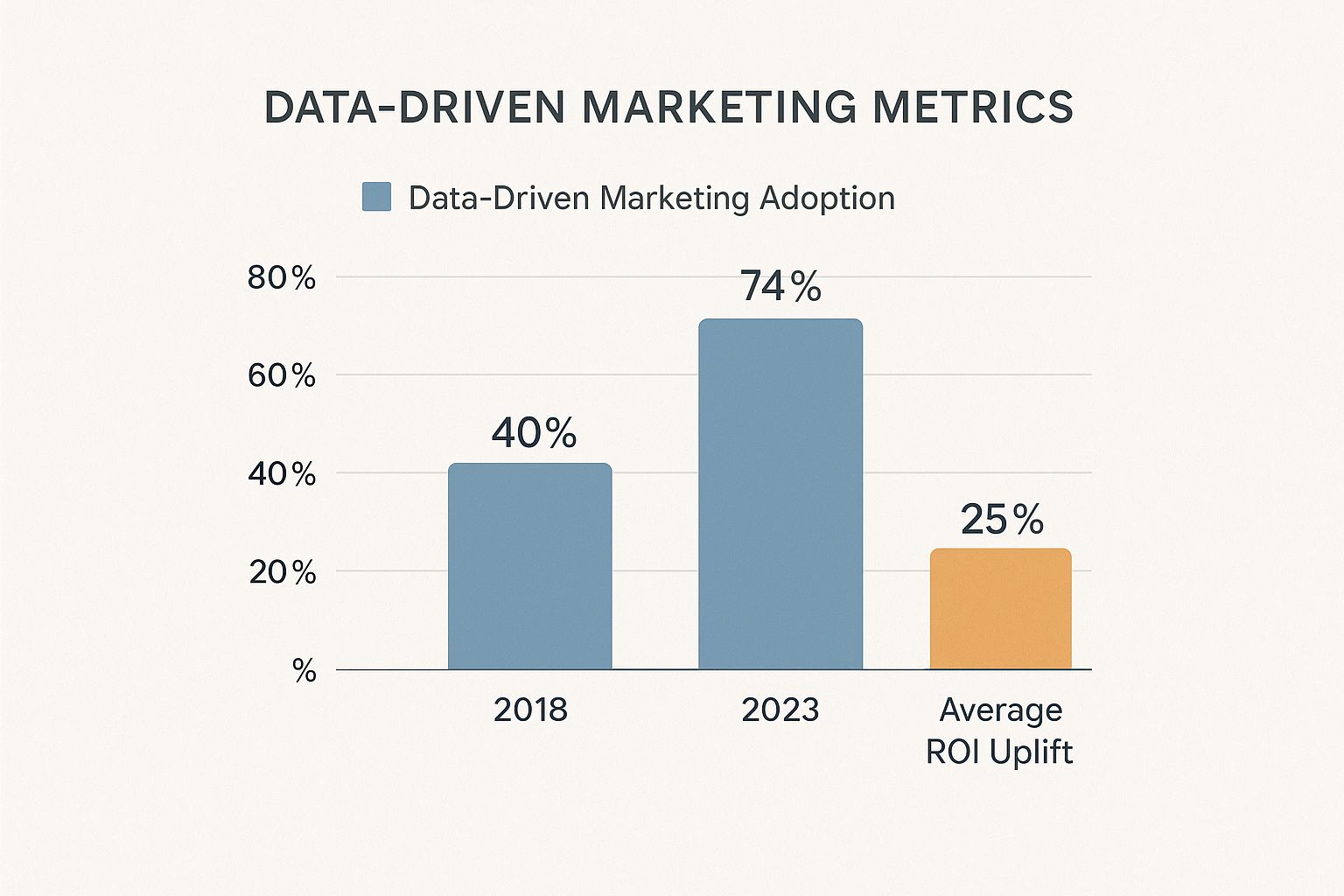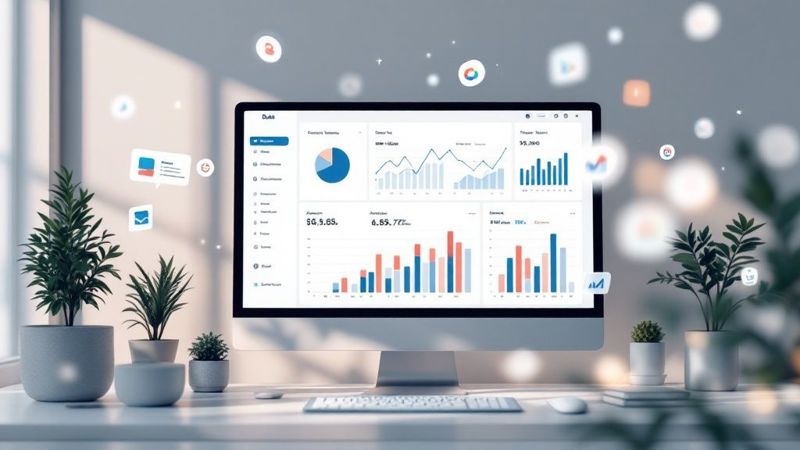Data-driven marketing is all about swapping guesswork for genuine customer insights to shape your marketing decisions. Instead of just relying on intuition, you use hard facts about customer behavior to connect with people in a way that actually feels personal and relevant.
What Is Data Driven Marketing Exactly?
Think about trying to find your way through a new city. You could wander around, guessing which streets lead to your destination, or you could use a GPS that gives you a clear, step-by-step route based on real-time traffic. Data-driven marketing is that GPS for your business. It’s an approach where you base your strategic decisions on the data you've collected, not on assumptions.
It completely transforms marketing from a game of chance into something much more predictable.
The core idea is pretty simple: listen to what your customers are telling you through their actions. Every click, every purchase, and every interaction is a tiny piece of the puzzle. When you collect and analyze this information, you start to understand what your audience truly wants, how they like to be contacted, and what messages will actually stick.
This infographic shows just how quickly businesses are jumping on board and the incredible returns they're seeing.

This isn't just a niche tactic anymore; it's become a core business strategy. And for good reason—it delivers an average ROI uplift of 25%.
Shifting From Guesswork To Certainty
Traditionally, marketing was a bit like casting a wide net and hoping for the best. Campaigns were aimed at a general audience, hoping to snag a small percentage of people who might be interested. It was often inefficient and expensive.
Data-driven marketing flips that model on its head by focusing on precision. Instead of a wide net, think of it as using a finely-tuned fishing rod.
To really see the difference, it helps to put the two approaches side-by-side.
Traditional Marketing vs Data Driven Marketing
This table breaks down the fundamental shift in thinking and execution between the old-school approach and the modern, data-backed method.
| Aspect | Traditional Marketing Approach | Data Driven Marketing Approach |
|---|---|---|
| Decision-Making | Based on intuition, experience, and general market assumptions. | Based on customer data, analytics, and measurable performance metrics. |
| Targeting | Broad demographic segments (e.g., "women aged 25-40"). | Highly specific audiences based on behavior, purchase history, and engagement. |
| Personalization | Generic, one-size-fits-all messaging for large groups. | Individualized content, product recommendations, and offers. |
| Measurement | Difficult to track ROI accurately; relies on proxies like brand awareness. | Direct attribution of conversions and revenue to specific campaigns. |
As you can see, the change goes far beyond just using new tools. It’s about a fundamental shift in mindset.
It's about building a marketing engine that is constantly learning from customer interactions. With every campaign, it gets smarter, more efficient, and ultimately, more profitable.
Understanding the Core Principles

At its heart, data-driven marketing is way more than just grabbing numbers and stats. It's about putting that information to work in a smart, repeating cycle.
Think of it like a master chef in the kitchen. They don't just have ingredients (your data); they have a proven recipe (analysis) and flawless cooking techniques (execution) to create something amazing. This approach really comes down to three foundational pillars.
The first pillar is high-quality data collection. This isn't about hoarding every byte of information you can find. It’s about carefully collecting clean, relevant data from all the places your customers interact with you—website analytics, CRM notes, social media likes, and email clicks.
From Raw Data to Actionable Insights
Once you have the right ingredients, it’s time for the second pillar: insightful analysis. Raw data by itself is just noise. The real magic happens when you find the signal within that noise, uncovering patterns that tell you exactly what your customers want and how they behave.
This is where you move from having data to understanding it. In fact, mastering data analysis for marketing success is one of the most critical skills you can develop in this field.
This analysis phase answers the big questions:
- Which marketing channels are actually bringing in my best customers?
- What kind of content genuinely connects with different audience segments?
- Where are people dropping off during the buying process?
"The aim of marketing is to know and understand the customer so well the product or service fits him and sells itself." - Peter Drucker
Drucker’s words perfectly capture the goal here, which leads us straight into the final, most important pillar.
Activating Insights for Personalization
The third principle is strategic execution and personalization. All those brilliant insights you uncovered are completely worthless until you do something with them. This is the part where you use what you’ve learned to tailor every single interaction, from the ads a person sees to the emails that land in their inbox.
Today's customer journey isn't a straight line; it can involve anywhere from 20 to 500 touchpoints. With a path that fragmented, using data to personalize the experience is essential. It's no surprise that 64% of marketing executives ‘strongly agree’ that this approach is critical to staying competitive.
But it doesn't stop there. This whole process is a loop. Every personalized campaign you run generates new data on what worked and what didn't. That new information then feeds right back into the cycle, sharpening your analysis and making your next move even smarter. It creates a powerful feedback loop where every action makes the next one better.
Why This Approach Delivers Real Business Growth
Top companies aren't just jumping on the data-driven marketing bandwagon because it's trendy. They're shifting their budgets because it delivers clear, tangible results. This whole approach is about moving past buzzwords and translating data directly into measurable growth. It’s the difference between crossing your fingers and hoping for success versus actually engineering it.
The most immediate win? A serious boost to your return on investment (ROI). Instead of spraying your budget across a dozen channels and guessing what’s working, data shows you exactly where your best customers are coming from. This clarity lets you slash wasteful ad spend and pump those funds back into the campaigns that are actually making the phone ring.
When you know precisely what’s effective, you can learn how to measure marketing campaign success with far greater accuracy. Every dollar starts working harder, directly fattening up your bottom line.
Deeper Customer Connections Drive Loyalty
Beyond just saving cash, data helps you build genuinely stronger, more profitable relationships with your customers. When you analyze browsing habits, purchase history, and how people interact with your content, you can start crafting highly personalized experiences. These are the moments that resonate on an individual level and turn one-time buyers into loyal brand fans.
And personalization isn't just a "nice-to-have" feature; it's a massive revenue driver. In fact, personalization powered by advanced analytics can lift revenues by 5-15% and boost marketing efficiency by 10-30%. It’s no surprise that 32% of marketers now report their data-driven strategies as being very successful.
This is also where you can see how specific tactics, like using UGC for SEO, become even more powerful when you use data to optimize their performance.
Making Smarter Decisions Faster
In a market that moves at lightning speed, the ability to pivot quickly is a massive competitive advantage. Data-driven marketing takes the guesswork out of big decisions. Forget those slow, debate-filled meetings; now you can take fast, confident actions backed by cold, hard evidence. When a market trend shifts or a competitor makes a move, you can analyze real-time data and react instantly.
This agility allows you to not just respond to change but to get ahead of it. By spotting emerging patterns in customer behavior, you can proactively tweak your strategy and stay ahead of the curve.
This proactive mindset creates a culture of constant improvement. Your key advantages become:
- Optimized Resource Allocation: You know exactly where to put your time, money, and team’s energy for the biggest impact.
- Enhanced Product Development: Customer data gives you direct feedback on what features people love and what they’re crying out for next.
- Reduced Risk: Launching new campaigns or products feels a lot less like a gamble when your decisions are validated by real data.
Ultimately, this data-centric approach builds a powerful engine for growth. It perfectly aligns your marketing efforts with what your customers actually want, ensuring every move you make is strategically sound and geared for sustainable, long-term success.
Building Your Data-Driven Marketing Toolkit

A skilled woodworker needs the right tools to bring a vision to life. The same goes for a data-driven marketer. To turn raw information into revenue, you need a technology stack that can collect, analyze, and activate your customer data effectively. Think of this as building your workshop.
The foundational tool for most businesses is a Customer Relationship Management (CRM) system. Platforms like Salesforce or HubSpot act as your central memory, logging every customer interaction, from sales calls to support tickets. This creates a detailed history that is absolutely essential for understanding each customer relationship.
Turning Numbers Into Narratives
Next up, you need tools to understand what people are actually doing on your website and apps. This is where analytics platforms come into play.
Web Analytics platforms like Google Analytics are non-negotiable. They act like a heatmap for your website, showing you which pages are popular, where visitors are coming from, and how they navigate through your content. This information is gold for optimizing the user experience and boosting conversion rates.
But having tons of data can quickly get overwhelming. That’s why Data Visualization tools are so important. Software like Tableau or Microsoft Power BI transforms complex spreadsheets into clear, interactive dashboards. They turn rows of numbers into visual stories, making it a breeze to spot trends and share insights with your team.
Creating a Single Source of Truth
As your business grows, customer data often gets scattered across different systems, creating silos and confusion. In fact, solving this is one of the most common data integration problems marketers face today.
This is the exact challenge a Customer Data Platform (CDP) is designed to solve. A CDP is the master key that unlocks a unified customer view. It pulls data from your CRM, website, email platform, and other sources into one comprehensive profile for each and every customer. This "single source of truth" is the backbone of truly effective personalization.
By bringing all your data together, a CDP allows you to orchestrate highly relevant customer journeys across every touchpoint, ensuring a consistent and personalized experience.
To put it all together, here’s a quick look at the essential tools that make up a modern marketing tech stack.
Your Data-Driven Marketing Tech Stack
This table breaks down the core categories, what they do, and a few popular examples to get you started.
| Tool Category | Primary Function | Popular Examples |
|---|---|---|
| CRM | Manages and tracks all customer interactions and relationships. | Salesforce, HubSpot |
| Analytics | Measures website traffic and user behavior to find insights. | Google Analytics, Adobe Analytics |
| Visualization | Converts raw data into easy-to-understand charts and reports. | Tableau, Looker Studio |
| CDP | Unifies customer data from multiple sources into a single view. | Segment, Tealium |
With these tools in your workshop, you’ll have everything you need to start turning data into decisions—and decisions into dollars.
How AI Is Supercharging Data-Driven Marketing
If customer data is the fuel for your marketing engine, think of Artificial Intelligence (AI) and Machine Learning (ML) as the twin turbochargers that give it incredible speed and precision. AI takes the core ideas of data-driven marketing and just cranks them up to eleven, automating complex tasks that would be completely impossible for a human team to handle.

It’s like having thousands of analysts working for you around the clock. AI algorithms can sift through massive datasets in real time, spotting hidden patterns, predicting what customers will do next, and tweaking campaign performance on the fly. This is a genuine game-changer for how businesses connect with their audiences.
Unlocking Predictive Power and Personalization
One of the most powerful things AI brings to the table is predictive analytics. By analyzing past behavior, AI models can forecast which customers are most likely to convert, which ones are at risk of leaving, and what products they’ll probably buy next. This lets you get ahead of the curve and engage customers with the perfect message at just the right moment.
AI also enables personalization on a scale we've never seen before. Here’s where it really shines:
- Dynamic Content Optimization: AI can automatically test thousands of combinations of headlines, images, and calls-to-action to find the winning version for different customer segments.
- Real-Time Ad Bidding: Instead of static bids, AI algorithms can adjust ad bids instantly based on how likely a specific user is to convert, making sure you get the most out of every dollar spent.
- Automated Content Creation: Generative AI has become a huge part of content creation automation, helping teams draft personalized email copy, social media posts, and ad variations in seconds.
AI is quickly becoming a non-negotiable part of modern marketing, fueling faster and more accurate decision-making. The global AI marketing industry is already valued at approximately $47.32 billion.
Even with these incredible advancements, many are still catching up. An international survey found that only 17% of marketers use AI extensively, while 39% apply it more selectively. Businesses are finding clever applications for this tech, like using real-time analytics and AI in event networking to forge better connections.
At the end of the day, integrating AI is no longer a luxury—it’s a competitive necessity for any serious marketing team.
Learning from the Giants in the Real World
Theory is great, but seeing data-driven marketing in action is where the lightbulb really goes on. Some of the world's biggest brands didn't just stumble into success; they built their empires on this exact approach. They’ve turned mountains of data into seamless customer experiences and, frankly, incredible profits.
Let's break down a few powerful examples.
Netflix: Engineering a Blockbuster
Netflix has pretty much turned content creation into a science. The platform doesn't just guess what you'll watch next based on your viewing history. It digs way deeper, analyzing millions of data points—like which scenes you rewind, where you hit pause, and even which actors you seem to follow from one series to another.
This intel gives them the confidence to greenlight multi-million dollar productions because they already know an audience is waiting. It completely flips the script on the high-stakes gamble of content creation. They don’t just hope for a hit; they engineer one.
Amazon’s Eerily Good Recommendation Engine
Ever get that feeling Amazon knows what you need before you do? That’s their legendary recommendation engine at work. It’s a masterclass in data-driven marketing, tracking every search, click, and purchase to build a shockingly accurate profile of your habits and interests.
This engine isn't just a neat feature—it’s responsible for an estimated 35% of the company's total sales. It's a perfect example of how personalized suggestions, powered by behavioral data, can become a core driver of a business, keeping customers coming back for more.
Spotify’s Secret Sauce for Music Discovery
Spotify’s “Discover Weekly” playlist often feels like it was curated by a friend who just gets your taste in music. That’s not magic; it’s just incredibly smart data analysis.
By looking at your listening habits—the songs you add to playlists, the ones you skip, the artists you have on repeat—Spotify’s algorithms can predict what new music you’ll love with stunning accuracy. This creates a deeply personal experience that keeps millions of subscribers hooked. It's the ultimate proof that when you use data to provide genuine value, you build unshakable brand loyalty.
Your Questions, Answered
Jumping into data-driven marketing can feel a little overwhelming, and it's natural to have questions. Let's tackle some of the most common ones that pop up when you're just getting your bearings.
How Can a Small Business Start with Data-Driven Marketing?
You don't need a massive budget or a team of data scientists to get going. The best way for a small business to start is by using the free and powerful tools you probably already have access to.
Start with Google Analytics. It's a goldmine for understanding who is visiting your website and what they do when they get there. At the same time, dig into the built-in analytics on your social media pages. They’ll tell you exactly what kind of content makes your audience tick. Even a simple email survey can give you incredible feedback straight from your customers.
The trick is to start small. Don’t try to track everything at once. Pick one or two metrics that really matter to your business—like your website's conversion rate or how many people are engaging with your posts—and focus on improving those. A real commitment to making decisions based on the data you have is far more valuable than any expensive software.
What’s the Difference Between Data Analytics and Data-Driven Marketing?
This is a great question, and it's easy to get them mixed up. The simplest way to think about it is that one is the "engine" and the other is the "car."
Data analytics is the technical work of digging through raw information to find trends, spot useful patterns, and figure out what it all means. It’s the engine that crunches the numbers.
Data-driven marketing, on the other hand, is the art of using those findings to hit a specific business goal. It's the car that the engine powers, steering your strategy in the right direction.
In short, analytics gives you the insight (like, "Hey, customers who buy our running shoes also look at our moisture-wicking socks"). Data-driven marketing is what you do with that insight (like creating a campaign that automatically shows an ad for those socks to someone right after they buy the shoes).
What Are the Biggest Challenges of This Strategy?
While the payoff is huge, shifting to a data-driven approach definitely comes with a few common roadblocks. Getting ahead of them is the key to making it work.
The three biggest hurdles we see are:
- Data Quality: If your data is messy, incomplete, or just plain wrong, any decisions you make based on it will be flawed. Garbage in, garbage out. Making sure your data is clean and reliable has to be step one.
- Lack of Skills: A lot of teams just don't have people with the right analytical skills to make sense of the data or use the tools effectively. It's not about everyone becoming a data scientist, but a baseline understanding is crucial.
- Organizational Silos: Often, valuable data is locked away in different departments. Marketing has its data, sales has theirs, and customer service has its own. When these teams don't talk, you never see the full picture.
To get past these issues, you need to invest in good data management practices, train your team to build their confidence with data, and create a culture where sharing information across the company is the norm.
Ready to make every marketing interaction personal and engaging? With OKZest, you can automate the creation of personalized images that capture attention and drive results. See how it works at https://okzest.com.